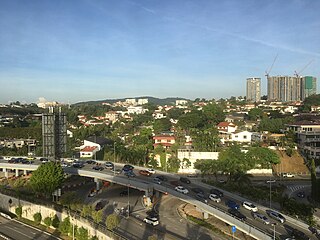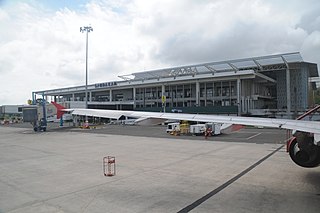
General aviation (GA) is defined by the International Civil Aviation Organization (ICAO) as all civil aviation aircraft operations except for commercial air transport or aerial work, which is defined as specialized aviation services for other purposes. However, for statistical purposes, ICAO uses a definition of general aviation which includes aerial work.

An aviation accident is defined by the Convention on International Civil Aviation Annex 13 as an occurrence associated with the operation of an aircraft, which takes place from the time any person boards the aircraft with the intention of flight until all such persons have disembarked, and in which (a) a person is fatally or seriously injured, (b) the aircraft sustains significant damage or structural failure, or (c) the aircraft goes missing or becomes completely inaccessible. Annex 13 defines an aviation incident as an occurrence, other than an accident, associated with the operation of an aircraft that affects or could affect the safety of operation.

Brunei International Airport (BIA), , is the primary international airport, one of two airports in the Sultanate of Brunei Darussalam, on the island of Borneo.

Penang International Airport (PIA) (IATA: PEN, ICAO: WMKP) is an international airport in George Town, the capital city of the Malaysian state of Penang. The airport is located at the southeastern tip of Penang Island, 16 km (9.9 mi) south of the city centre, and serves the country's second largest conurbation.

RMAF Kuala Lumpur was an air base in Kuala Lumpur. It is also known as Sungai Besi Air Base, Simpang Airport, Old Airport.

Damansara Heights is an upscale suburb in western side of Kuala Lumpur, Malaysia, located five kilometres away from the city centre. The suburb falls under the Segambut district and its parliamentary constituency. It is a sought-after residential and commercial address in Klang Valley.

Sandakan Airport is a domestic airport which serves Sandakan in Sandakan District, Sabah, Malaysia. It is located 14 km (8.7 mi) west of downtown Sandakan. In 2005, the airport handled 621,513 passengers and registered 10,876 flights.

Miri International Airport is an airport located 9.5 km (5.9 mi) south east of Miri, a city in the Malaysian state of Sarawak. The airport is the sixth-busiest airport in Malaysia, and the second-busiest in Sarawak.

Mukah Airport is an airport in Mukah, a town in the state of Sarawak in Malaysia.

Tioman Airport, also known as Pulau Tioman Airport, is an airport serving Tioman Island, Pahang, Malaysia. It is located next to Tekek village . The relatively small size of aircraft able to take off and land at Tioman means that per seat costs are relatively high making it hard for airlines operating out of the island to remain profitable. The airport's runway is "one way" as planes can only land from and take off in one direction (north) due to nearby terrain. Tioman is a popular destination for private pilots based in Singapore and Malaysia, as it is only a little more than one hour away by air from Seletar Airport compared to over 5 hours by surface transport.

Kenya Civil Aviation Authority (KCAA) is a state corporation of Kenya that is responsible for regulating the aviation industry in Kenya and for providing air navigation services in the Kenya flight region.
The Department of Civil Aviation was a government department of Thailand from 2009 to 2015. Founded in 1933 as a bureau under the Ministry of Commerce's Department of Transport, it was elevated to department status under the new Ministry of Transport in 1963, and was originally called the Department of Commercial Aviation. It was renamed the Department of Air Transport in 2002, before becoming the Department of Civil Aviation in 2009. The department's responsibilities included prescribing, regulating, and auditing Thai civil aviation, as well as the management of Thailand's government-owned civil airports.

The Directorate General of Civil Aviation (DGCA) is a statutory body of the Government of India to regulate civil aviation in India. It became a statutory body under the Aircraft (Amendment) Act, 2020. The DGCA investigates aviation accidents and incidents, maintains all regulations related to aviation and is responsible for issuance of licenses pertaining to aviation like PPL's, SPL's and CPL's in India. It is headquartered along Sri Aurobindo Marg, opposite Safdarjung Airport, in New Delhi. The Government of India is planning to replace the organisation with a Civil Aviation Authority (CAA), modelled on the lines of the American Federal Aviation Administration (FAA).

The Ministry of Transport, abbreviated MOT, is a ministry of the Government of Malaysia that is responsible for transport: road transport, civil aviation, marine, road safety, port authority, railway assets, maritime, air accident investigation, logistic, maritime safety, shipping, rail transport, airport, airline.

The Department of Civil Aviation, Myanmar is an agency of the government of Burma. It is subordinate to the Ministry of Transport.

Regulation of unmanned aerial vehicles (UAVs) involves setting safety requirements, outlining regulations for the safe flying of drones, and enforcing action against errant users.
MYAirline was a Malaysian low-cost airline founded in 2021. It was headquartered in Subang Jaya, Selangor and primarily operated from KLIA2, the low-cost carrier terminal of KLIA. The airline began its maiden flight on 1 December 2022 to Kuching International Airport. The company slogan was Your Experience Matters.

The Malaysian Aviation Commission is a regulatory body for the aviation industry in Malaysia under the Ministry of Transport. Established in 2016, it entrusted to regulate the economic and consumer issues of the civil aviation sector.

















